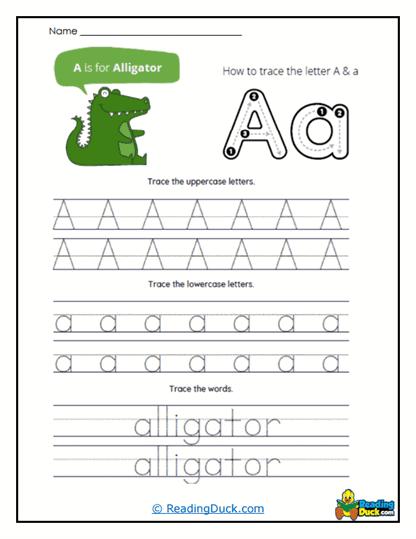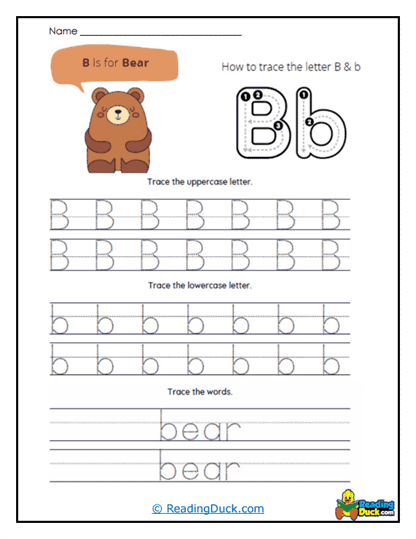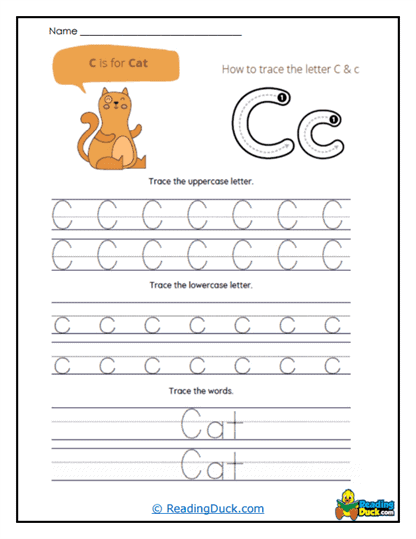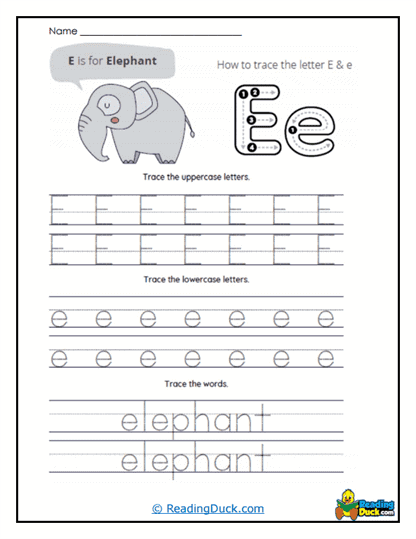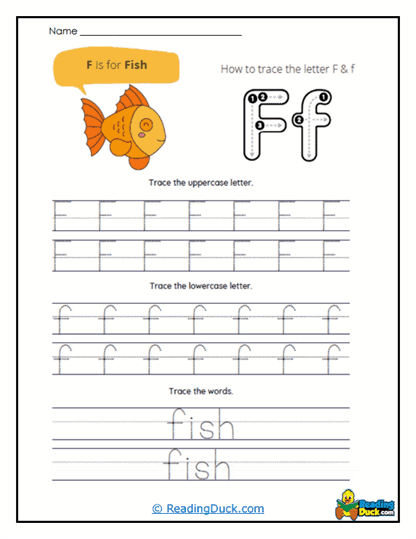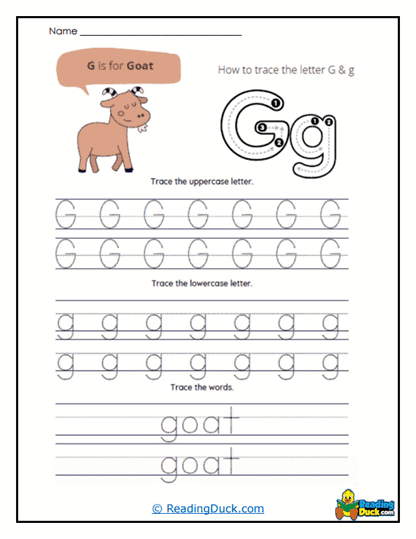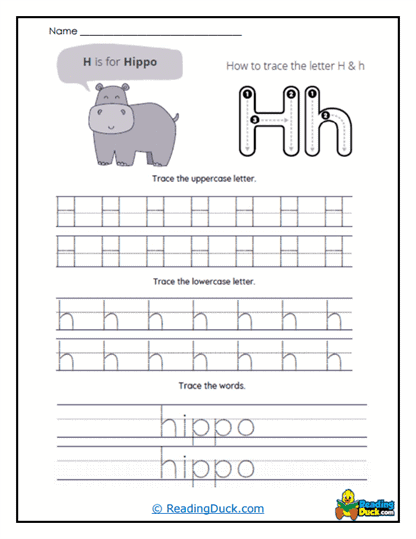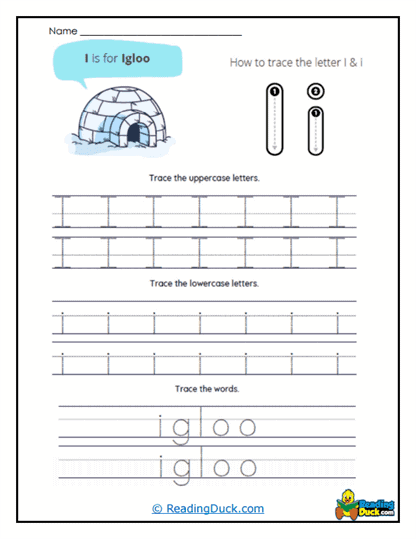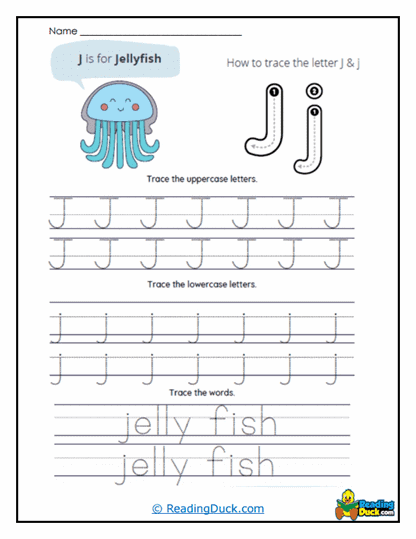Alphabet Tracing Worksheets
About Our Alphabet Tracing Worksheets
Our Alphabet Tracing Worksheets are specifically designed to engage young learners in developing their foundational pre-reading and writing skills. This collection includes a worksheet for every letter of the alphabet, from A to Z. Each worksheet features a picture that corresponds to a word beginning with the featured letter. The letter is presented in a bubble letter style with numbered strokes to guide students on the correct way to write it. Students are then guided to trace both the uppercase and lowercase versions of the letter multiple times, followed by tracing the word represented by the picture twice. These worksheets are available in PDF format, making them easily accessible for electronic viewing, downloading, and printing.
Understanding the Importance of Alphabet Tracing
The Foundation of Literacy Development
Alphabet tracing is a crucial activity for young learners as it lays the foundation for reading and writing skills. Mastering letter formation is the first step towards becoming proficient in writing, which is an essential skill for academic success. Tracing activities not only help children recognize letters but also instill the muscle memory needed to write letters accurately and fluently. Here’s why alphabet tracing is so important:
- Letter Recognition: Before children can write letters independently, they must first recognize and differentiate them. Tracing worksheets provide a visual and tactile experience that reinforces letter recognition.
- Fine Motor Skills: Tracing letters helps young students develop the fine motor skills necessary for writing. The act of holding a pencil and following the guided strokes strengthens the muscles in the hands and fingers, improving coordination.
- Understanding Letter Formation: By following the numbered strokes on the bubble letters, students learn the correct sequence and direction for forming each letter. This ensures that they develop proper writing habits early on.
- Phonemic Awareness: Associating letters with sounds is a key aspect of learning to read. Tracing activities often include images of objects that start with the corresponding letter, helping students connect the sound with the written symbol.
The Role of Tracing in Early Education
Alphabet tracing is more than just a writing exercise; it’s an integral part of early education that supports multiple aspects of cognitive and language development. Engaging in tracing activities allows children to:
- Build Confidence: As students successfully trace letters and words, they gain confidence in their abilities. This confidence encourages them to take on more complex tasks as they progress in their education.
- Develop Attention to Detail: Tracing requires focus and precision. By paying close attention to the shapes and strokes of each letter, students enhance their attention to detail, which is a valuable skill across all areas of learning.
- Encourage Independence: While tracing worksheets provide structure and guidance, they also encourage independence. As students become more comfortable with tracing, they may begin to write letters and words on their own, fostering a sense of autonomy.
- Introduce Early Literacy Concepts: Tracing the letters and corresponding words introduces young learners to basic literacy concepts. They begin to understand that letters form words, and words convey meaning, laying the groundwork for reading and writing.
Integrating Alphabet Tracing Worksheets into the Curriculum
Creative Ideas for Classroom and Home Use
Alphabet Tracing Worksheets can be seamlessly integrated into a variety of educational settings, whether in the classroom or at home. Here are some practical ideas and tips on how to effectively use these worksheets:
- Daily Writing Practice: Incorporate alphabet tracing into the daily routine. Begin each day with a short tracing activity to reinforce letter recognition and writing skills consistently.
- Letter of the Week: Focus on one letter each week, using the tracing worksheet as the core activity. Complement the tracing with additional activities like crafts, songs, and stories related to the letter.
- Interactive Learning Stations: Set up a learning station in the classroom where students can independently work on tracing worksheets. This promotes self-directed learning and allows students to practice at their own pace.
- Homework Assignments: Send tracing worksheets home as part of a homework assignment. This allows parents to engage with their child's learning and provides additional practice outside of the classroom.
- Letter Recognition Games: After students complete their tracing worksheets, incorporate games that reinforce letter recognition, such as matching uppercase and lowercase letters or finding objects that start with the traced letter.
- Alphabet Books: Have students compile their completed tracing worksheets into an “Alphabet Book.” This not only serves as a personalized learning resource but also gives students a sense of accomplishment.
- Group Activities: Encourage collaborative learning by having students work in pairs or small groups to complete tracing worksheets. This promotes social interaction and peer learning.
- Technology Integration: For classrooms with access to tablets or interactive whiteboards, consider using digital tracing apps that complement the worksheets. This can add an element of technology to the learning process and engage tech-savvy students.
Targeted Grade Levels
These Alphabet Tracing Worksheets are most beneficial for students in Pre-Kindergarten through Kindergarten. They are designed to align with the developmental stages of children in these grade levels, where letter recognition and fine motor skill development are key focuses. Additionally, first graders who need extra support in letter formation and early writing skills can also benefit from these worksheets. ESL (English as a Second Language) students at various ages may also find these worksheets helpful as they familiarize themselves with the English alphabet and writing conventions.
The Educational Value of Alphabet Tracing
Skill Development Through Structured Practice
Engaging in Alphabet Tracing Worksheets offers young learners a structured approach to developing essential skills that are crucial for their academic journey. The activities within these worksheets contribute to the following areas:
- Fine Motor Skills: The act of tracing letters involves the careful coordination of hand muscles, which is necessary for writing. Regular tracing practice strengthens these muscles, improving a child’s ability to write legibly and comfortably.
- Letter Recognition: Repeated exposure to letters through tracing helps solidify letter recognition, which is foundational for reading and writing. Students learn to identify each letter by sight and associate it with its corresponding sound.
- Cognitive Development: Tracing worksheets require students to follow directions and complete tasks in a specific order, enhancing their cognitive development. The process of tracing letters according to numbered strokes also supports memory and sequencing skills.
- Attention and Focus: Completing a tracing worksheet requires sustained attention and focus. Students must concentrate on staying within the lines and following the correct stroke order, which helps develop their ability to focus on tasks over time.
- Confidence and Independence: As students practice and improve their tracing skills, they build confidence in their abilities. This confidence translates to greater independence in writing and other academic tasks.
- Early Literacy Skills: By tracing both letters and words, students are introduced to the concept that letters form words and words have meaning. This is an important step in early literacy development, as it prepares students for reading and writing.
Conclusion: The Impact of Alphabet Tracing on Early Learning
Alphabet Tracing Worksheets are a powerful tool in early education, offering young learners a hands-on, engaging way to develop their pre-reading and writing skills. By integrating these worksheets into your curriculum, you provide students with the opportunity to build a strong foundation in literacy, fine motor skills, and cognitive development. The structured yet enjoyable nature of tracing activities fosters a love for learning and equips students with the skills they need to succeed in their academic journey. Whether used in the classroom or at home, these worksheets serve as an invaluable resource for helping young students achieve their full potential in early literacy.
